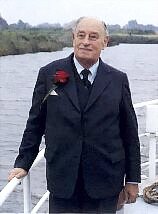Tag Archives: collection
New virtual exhibitions
The Virtual Van Diepen Museum
On these special pages you can view two new exhibitions with artworks of the Jan Menze van Diepen Foundation in combination with interesting data.
Go along through the virtual rooms with the various beautiful objects from the collection.
Click on the picture and imagine yourself back in the museum.
1. A virtual exhibition with centuries-old Japanese ceramics.
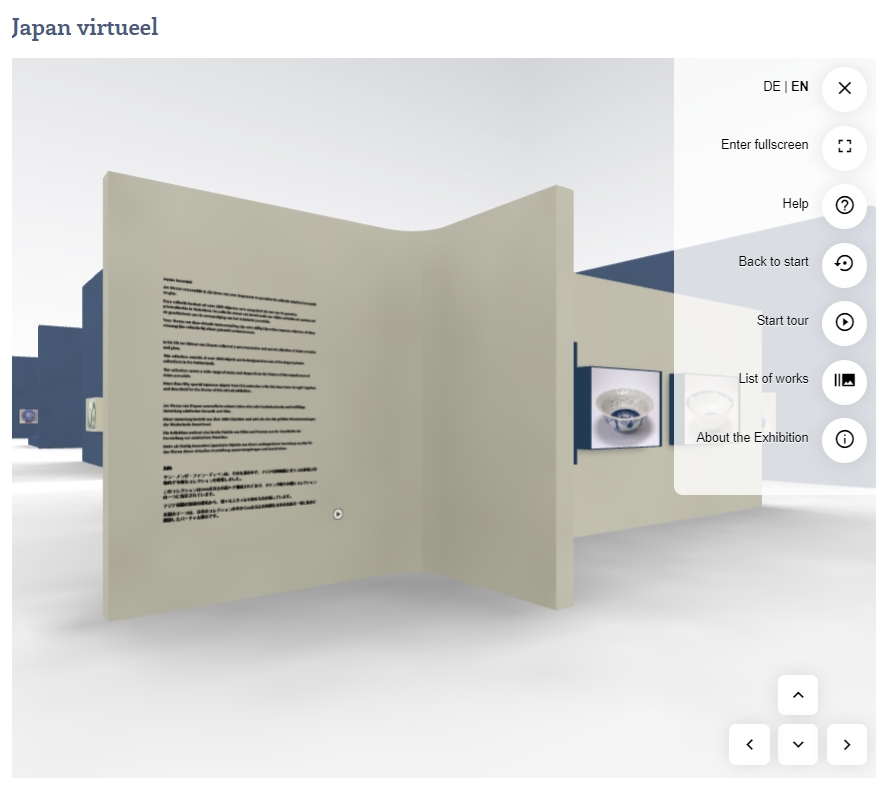
Click on the photo and step inside the virtual exhibition.
2. A virtual exhibition with a combination of graphics by Riekele Prins, the City of Groningen and a selection of visual art from the collection.

Click on the photo and enter the virtual exhibition.
Purchase unique Pronk dish
Recently, the Jan Menze van Diepen Foundation was able to purchase a beautiful dish from the famous Pronk dinner service of the Fraeylemaborg. This plate was offered at an auction in Bruges by a Frisian collector. Because of this acquisition, for the first time a part of the precious service can be shown in the Fraeylemaborg.

Until 1971 there was a unique Pronk service in the Fraeylemaborg, but in that year it was sold at Mak van Waay in Amsterdam. This extensive dinner service came from China, but was decorated with a representation by the Dutch artist Cornelis Pronk (1691-1759).
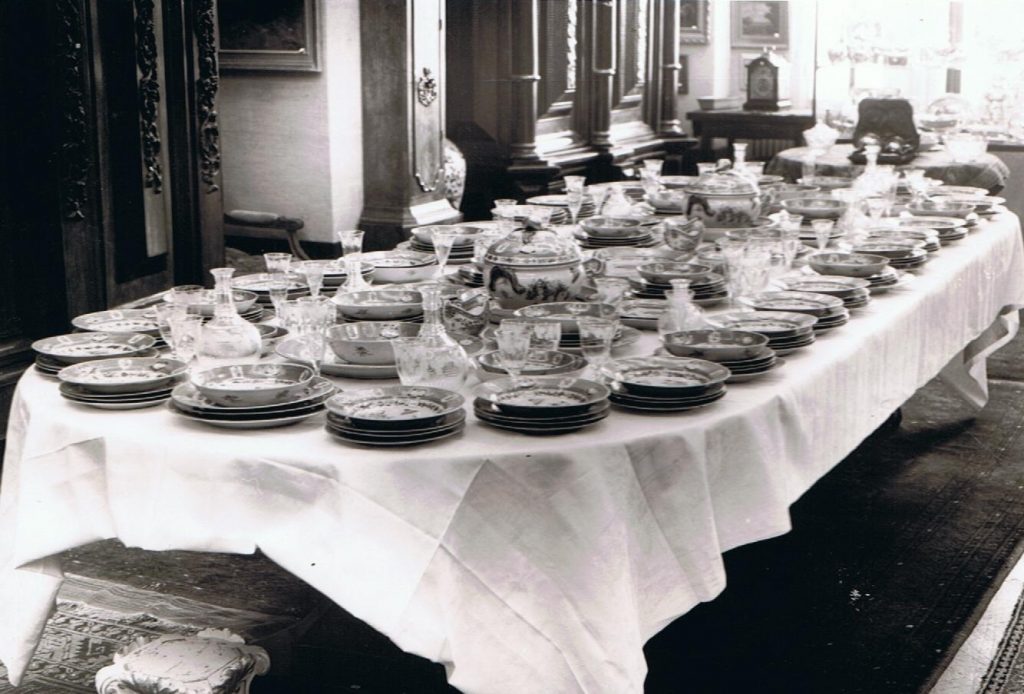
Pronk was commissioned by the Verenigde Oostindische Compagnie to make a design that was suitable for various types of tableware. He made a number of drawings in which he combined all kinds of oriental elements. Porcelain with these representations is also called “Pronk porcelain”. A striking element on one of his most beautiful drawings are elegant ladies holding a parasol. Porcelain with “The Parasol Ladies” has become a household name.
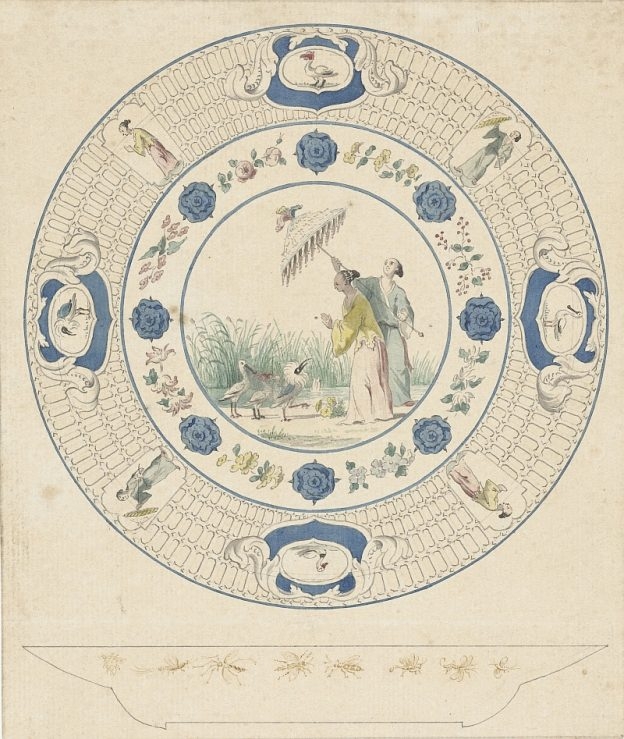
The drawings of Cornelis Pronk were sent via Batavia to China in 1735 and applied there on porcelain. This was a great success, but the cost of manufacture was so high that too little was earned. Production therefore stopped after only a few years. Pronk porcelain has therefore become rare and this is certainly true for complete tableware. The design drawing for the Parasol ladies is now in the Rijksmuseum collection.
The recently purchased dish is also exceptional because the central representation of the Paraol ladies is placed in a rectangular field, while on almost all known Pronk signs it is a round field.
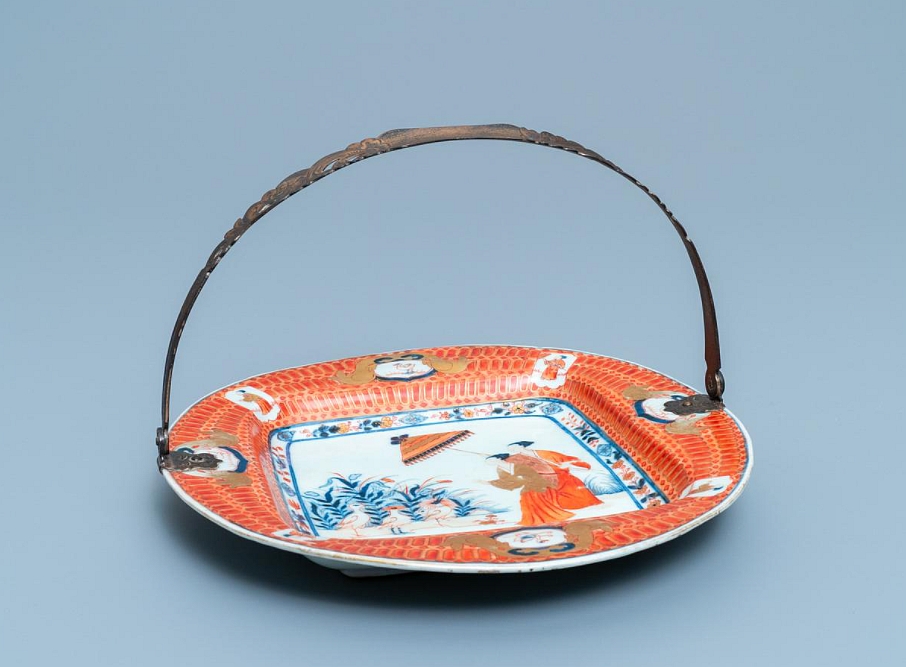
The Pronk crockery used to be placed on the table at the Fraeylemaborg in its heyday. For example at a wedding party or the reception of a high guest. Of course it was of great importance that this precious dinnerware was handled with care. According to tradition the servants and the cooks all received 25 guilders if nothing broke during such a dinner!
Visual arts
Visual arts
The Fine Art subcollection comprises more than 700 objects such as paintings, etchings, drawings and watercolors.
A large part of this is by Groninger artists, or has a relationship with Groningen. Van Diepen was also interested in the work of the Groningen art society “De Ploeg”.
Sparkling colour litho of Corneille
 In the Van Diepen collection is a sparkling colour litho of the famous artist Corneille.
In the Van Diepen collection is a sparkling colour litho of the famous artist Corneille.
Corneille Guillaume Beverloo was born in Liège, Belgium, from Dutch parents. From an early age he signed with his first name. I thought it was too pretentious to put my last name under what I had made.
He lived and worked in Liège until 1939, in Haarlem until 1940, and then followed lessons at the Rijksacademie in Amsterdam together with Karel Appel. A trip to Budapest in 1947 had a lasting impact on his work. He got to know the writings and work of Paul Klee and Joan Miró. He then travelled to many countries, including Africa and America. In these travels he sought the contrast between culture and nature, the tension between civilization and the primitive. From 1950 he lived and worked in Paris.
In 1948, Corneille was co-founder of the international COBRA group, named after the three local names from which the group members came: Copenhagen, Brussels and Amsterdam. An important concept for this group was the experiment, either individually or jointly. Equally important was internationalism, the contacts between artists from many countries.
The Cobra artists were champions of a free, spontaneous and natural art. They worked in a way that, according to the general public, looked childish and unskilled. That’s possible my son could also “was a phrase that was often used to characterize the work of Cobral members.
Corneille had many foreign contacts, but also the work of Dutch painters like Karel Appel and Constant attracted him. He was also very interested in the work of poets such as Elburg, Lucebert, Kouwenaar and Achterberg. In his graphic oeuvre he collaborated with Simon Vinkenoog and Hugo Claus.
Corneille practiced many techniques. He painted, watercoloured, drew, etched, lithographed and made wood and copper engravings. He used dynamic colours, and simple depictions with, for example, women, birds, trees and leaves. In his last years he had a studio in Paris. He lived in Auvers-sur-Oise, where he died on 5 September 2010. Corneille was buried there in the same cemetery as before Vincent van Gogh.
The colour litho of Corneille in Van Diepen collection is not dated, but was purchased in 1961 and therefore from before that year. The representation is abstract, in which spheres and planes are scattered in two rectangular frames. The main colours are red, green, old pink and black.
Artist; Corneille (Corneille Guillaume Beverloo) (1922-2010)
Title; Without title
Dating; None
Signature; Bottom right-hand side (with pencil): Corneille
Technique; Color litho on paper, 9 / 120
Dimensions; 72 x 54 cm
Inventory number; JMD-O-084
Palace House ten Bosch painted from the garden side
This painting was made by J. J. Destree (1827-1888),and shows an original view at the Palace Huis ten Bosch in The Hague.
It’s painted from the garden side, with a diagonal view of the east facade. It shows the palace at the time of Queen Sophie (1818-1877), the first wife of King William III. She lived here for most of the year, after the (secret) separation in 1851.
Reinder Homan etcher by nature
Exhibition Koetshuis Fraeylemaborg, Slochteren
30 september 2017 t/m 18 maart 2018
One of the most famous etchers in the Netherlands, Reinder Homan, exhibits in the Koetshuis at the Fraeylemaborg. Ten works come from the collection of Jan Menze van Diepen.
Reinder Homan (Smilde, 1950) was captivated by this versatile and complicated technique during his studies at the Groningen Academy Minerva.
Professor Shelly Xue investigates the Chinese glass collection.
In connection with the preparations for the exhibition “Porcelain with character” (from 25 March 2017 to 22 October 2017) in the Municipality Museum in The Hague, curator Suzanne Lambooy was visiting Slochteren.
During the planned preparations and discussions on Chinese porcelain, our Chinese glass collection, which she did not know existed, was mentioned in passing. To her surprise, this collection was so large in size (approx. 250 objects), that she felt that more people needed to know about this.
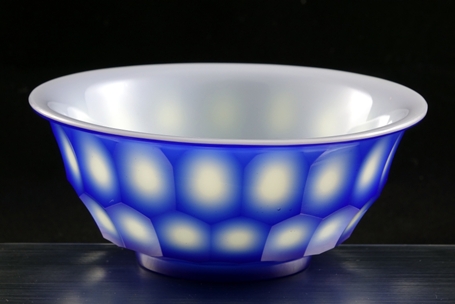
She knew that an expert from China in the field of Chinese glass would soon be in the Netherlands and might want to investigate this collection. Continue reading
Chinese snuff bottles and glass
Over 9,000 objects are in the extensive Van Diepen collection. In that, the proportion of the so-called snuff bottles is relatively limited, but there are about 160. But it is important to know what the background of these colorful bottles coming from China is.
What are snuff bottles?

Snuff bottle made of agate with decoration of a deer, China 1750-1850
In the 17th century, tobacco sniffing came into fashion with rich Chinese, introduced from Europe. Smoking tobacco was then forbidden, but finely ground tobacco was allowed. It was applied as a medication, it would help with colds, headaches, stomach problems and many other diseases.
The use first focused around the Beijing Imperial Court, but gradually spread over the elite of China. The beginning of the Quing Dynasty in 1644 was the start of a very productive period for the studios in which the snuff bottles were made.
How was the snuff bottle used? Continue reading
CHINA CHARACTER
THE STORY ON PORCELAIN
Exhibition from 25 March 2017 till 22 October 2017
Gemeentemuseum The Hague
Elegant brushstrokes with an instant appeal to the imagination: Chinese characters have something truly magical about them. Not only because of their intrinsic beauty –to Western eyes at least – but also because of their wonderful symbolism and the often extraordinary stories they can tell.
From 25 March, the Kunstmuseum of The Hague shows a special selection of Chinese objects out of the Van Diepen collection among chinese porcelain from other collections.
The exhibition China Character lets Chinese porcelain speak for itself by Continue reading
Ceramics
Ceramics concerning the House of Oranje-Nassau
Here can you search the Oranje-Nassau Collection in our database with detailed information
Some examples:
Jan Menze van Diepen
Jan Menze van Diepen.
Jan Menze van Diepen was born in 1905 in the city of Groningen, in a family of shipbuilders.
From an early age he had a love for art and history. In a period of over 50 years he collected a vast and varied collection.
From his parents he inherited his love of Asian ceramics. Building on their collection, he managed to put together a superb collection.
During the second world war he started another important part of the collection: prints and ceramics concerning the House of Orange-Nassau.
Van Diepen collected not only for himself. He tried as much as possible to let others enjoy.
Jan Menze van Diepen died in Haren, on February 26 1994.
Selection from the fine arts collection
First catalogue about the collection of the Jan Menze van Diepen Stichting.
In this catalogue 60 works, made by 30 artists, get special attention. This selection shows the versatile interests of Van Diepen for the fine arts of his time. The many coloured illustrations present paintings and water-colours, but also graphic art is ample represented.
The selection was made by Mrs. Drs. H. van Harten-Boers, curator of the Fraeylemaborg in Slochteren.
Author: Drs. H. van Harten-Boers
Isbn.nr: 90 805793 1 9
Number of pages: 96
Price soft cover version: € 10,=
Available at: De Fraeylemaborg in Slochteren.
Selection from the fine arts collection
First catalogue about the collection of the Jan Menze van Diepen Stichting.
In this catalogue 60 works, made by 30 artists, get special attention. This selection shows the versatile interests of Van Diepen for the fine arts of his time. The many colour illustrations present paintings and water-colours, but also graphic art is ample represented.
The selection was made by Mrs. Drs. H. van Harten-Boers, curator of the Fraeylemaborg in Slochteren.
Author: Drs. H. van Harten-Boers
Isbn.nr: 90 805793 1 9
Number of pages: 96
Price soft cover version: € 10,=
Available at Fraeylemaborg in Slochteren.
Collection management
Accessibility of the collection
Th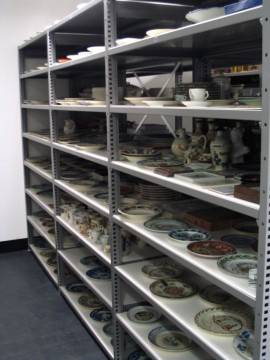 e registration of the collection (consisting of nearly 10.000 numbers) is classified in a computerized file. Of each object text and photo are available, within a system with good search possibilities. The daily administration takes place by a curator and a maintenance worker.
e registration of the collection (consisting of nearly 10.000 numbers) is classified in a computerized file. Of each object text and photo are available, within a system with good search possibilities. The daily administration takes place by a curator and a maintenance worker.
The foundation strives for enlarging the number of loans to museums and cultural institutions, to be in line with the intention of the collector Van Diepen.
There are also some predefined exhibitions, each with their own theme.
These exhibitions can be acquired in loan as a whole from the Jan Menze van Diepen Stichting, with accompanying text captions.
Topographic Groningen
Topographic maps and prints from the province of Groningen.
The collection topographic maps and prints includes over 600 special historical topographic maps and prints from the province of Groningen.
Jan Menze van Diepen was fascinated by the history of his own environment. This led him to the path of the topographic images. He acquired many cityscapes of Groningen, painted, drawn, or in a graphic technique .
Some examples;
Fine Arts
The Fine Arts collection includes more than 700 objects such as paintings, etchings, drawings and watercolors.
A large part of this is was made by Groninger artists, or has a relationship with Groningen.
Prints
Prints concerning the House of Oranje-Nassau.
Prints concerning the House of Oranje-Nassau.
The subcollection Orange-Nassau Prints includes over 3350 objects and can be considered as the largest private collection in the Netherlands.
Some examples:
Asian ceramics
Jan Menze van Diepen collected an impressive and varied collection of Asian ceramics and Asian glass.
This collection consists of more than 2800 objects and has been designated as one of the largest private collections in the Netherlands. The collection includes a wide range of styles periods and forms from the history of the manufacture of Asian porcelain.
Click here to see the Chinese porcelain in the database
Some examples;
In the sizeable Van Diepen collection, the share of so-called snuff bottles and Chinese glass is relatively limited, there are around 250. By European standards, this Asian glass collection is stil of a considerable amount.
Click here to see the Chinese glass in the database
Some examples;
Loans
Loans and exhibitions
Travelling Exhibitions
Besides the usual loans of one or more objects, the Jan Menze van Diepen Stichting has specially prepared for this purpose a number of exhibitions which can be acquired in loan as a whole.
Loan conditions
One of the aims of the Jan Menze van Diepen Foundation is to show the collection to interested parties.
That’s why the Foundation is eager to coōperate in giving loans to museums and cultural institutions.
Condition hereby is that the objects are exhibited in a appropriate way. Safety and en good climate conditions must be safeguarded.
All works of art on paper are lend framed.
Costs of transport and insurance are at the expense of the loan-taker.
Some examples of available exhibitions;
RIEKELE PRINS (1905-1954), engraver of the landscape of Groningen
Read more…
A VIEW ON GRONINGEN.
Read more…
ORANGE-SIGNS OF REMEMBRANCE
Read more…
Collections
In a period of over 50 years , Jan Menze van Diepen brought together a very extensive and varied collection.
The entire collection of nearly 10.000 objects can be divided into five main sub-collections:
1. Asian ceramics and glass ( approximately 2800 objects).
2. Oranje-Nassau prints (approximately 2600 objects).
3. Oranje-Nassau ceramics (approximately 1000 objects).
4. Visual arts (mainly Groninger artists (about 700 objects).
5. Topographic maps and prints of the province of Groningen (about 600 objects).
You can also search in a part of our database for specific objects with the details of these objects.
Search the collection
The Jan Menze van Diepen Foundation
This Foundation was established in 1978 by mr. Van Diepen, to guard and manage his collection in the future.
The purpose of this foundation speaks clearly for it self :
“The purpose of the foundation is to acquire, to administer and to exhibit for the public objects of art, ceramics, glass, prints, carts, photos, byjoux, furniture, curiosa and other pieces of art with historic value, as well as giving in loan these objects to institutions, with a similar aim as this foundation”.
The council of the Foundation is composed as follows:
Mr. J. Kuipers, chairman, secretary
Drs. R.T. Smid, treasurer
Drs. H.B.M. Bemboom, member
Co-workers:
Drs. H. van Harten-Boers, curator
H.L.F. Siemensma, registrator/conservation employee/webmaster




